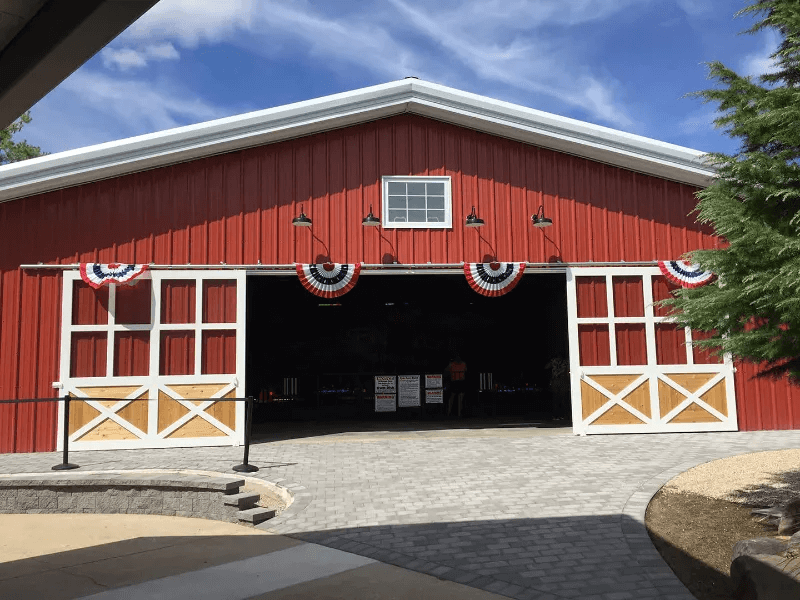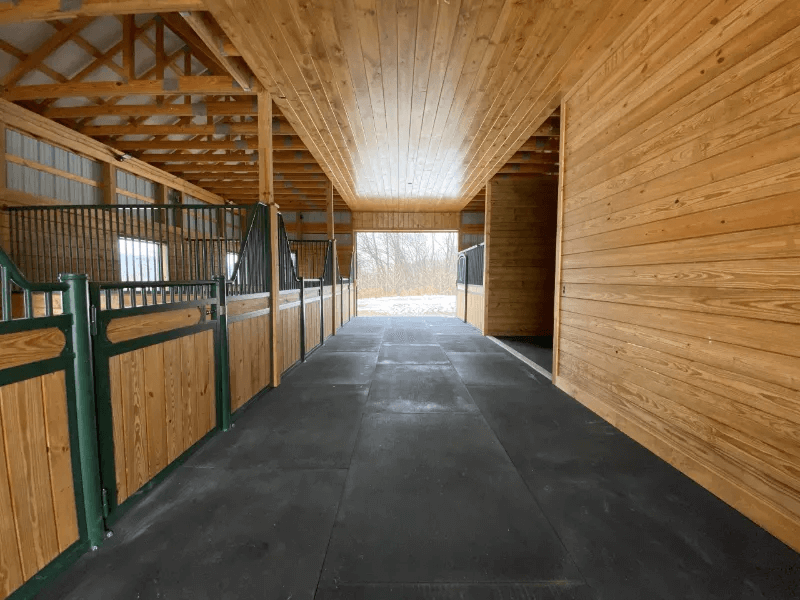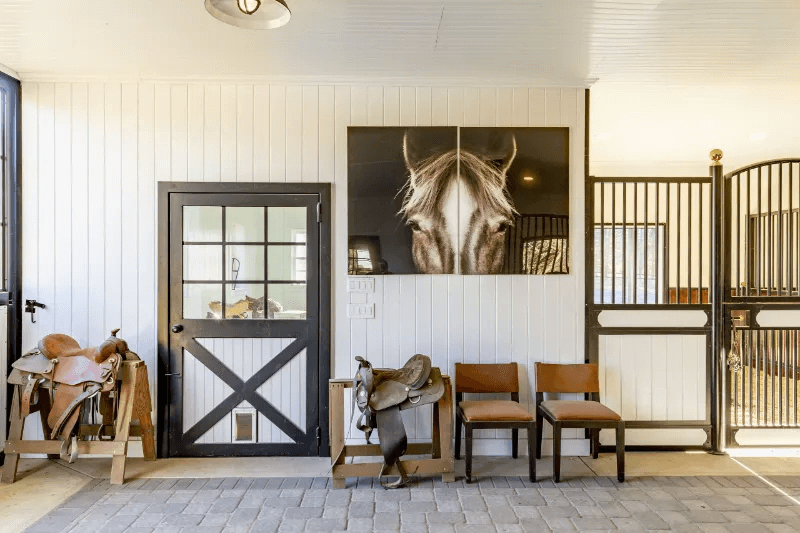Safety, like good design, is something that really never goes out of style does it?
This is especially true when it comes to barns, where the lives and wellbeing of horses are literally in our hands.
While traditional barn structures are usually pleasing to the eye, they often overlook the importance of modern architectural principles that ensure safety.
Among the most important, yet neglected aspects of barn design are doors. Modern barn doors, with their space-saving nature, ease of operation, and ability to enhance ventilation, nonetheless play an integral role in creating an equestrian facility that is both functional and attractive.
Read on to learn why quality barn doors are so important in modern equestrian facilities:
Low-quality or poorly constructed doors pose risks
While every aspect of an equestrian facility serves a purpose, few elements marry functionality, safety, and style as effectively as a well-constructed barn door. Well-designed doors are much more than a mere entry or exit point: they can ensure a safe, secure and comfortable environment for horses and help reduce injury risks to both horses and handlers on a day to day basis.
On the other hand, poorly made or ill-fitted doors can create a dangerous environment and pose several dangers to the well-being and safety of horses.

Here are some of the potential risks associated with using low-quality or inadequately constructed doors:
- Safety Hazards: Poorly made doors may have weak or unstable structures, increasing the risk of accidents such as door collapse or breakage.
- Entrapment and Injury: Doors with gaps, loose parts, or sharp edges can cause a horse to become trapped and panic. If a horse attempts to pass through or spooks near a poorly constructed door, it may result in serious injuries such as lacerations, sprains, or even bone fractures.
- Difficulty in Operation: Doors that are not properly installed or have subpar hardware can become difficult to open, close, or secure. This can create challenges during emergency situations, hindering quick and efficient evacuation or containment of horses.
- Security Risks: Low-quality doors may lack effective locking mechanisms, making them vulnerable to unauthorized access, theft, or release of horses. This compromises the security of the barn and puts the horses at risk of theft or injury if they wander outside.
- Poor Weather Protection: Inadequately sealed or poorly insulated doors may allow drafts, moisture, or pests to enter the barn. Extreme temperatures, excessive moisture, or the presence of biting insects can negatively impact the health and comfort of the horses.
- Noise: Doors that produce loud creaking, rattling, or banging noises during operation can startle the horses and cause unnecessary stress or anxiety. This can disrupt their routines, affecting their overall well-being and potentially lead to chronic behavioral issues.
To mitigate these risks, it is crucial to invest in high-quality doors specifically designed for horse barns.
Doors made of sturdy, robust materials are designed to withstand the considerable physical strength of horses and feature smooth surfaces and rounded edges to prevent injuries. Premium quality closing and locking mechanisms ensure doors are kept securely shut, keeping horses safely contained in their stalls when they are put away, thus minimizing the risk of accidental release.
A safe and bright environment
Creating a barn that is safe, enhances the wellbeing of the horses, and is visually appealing is the foremost priority for barn designers. For a design to be effective, barn doors should be implemented with safety and visibility in mind, allowing caretakers to quickly observe horses for any signs of distress or illness.

While fortified barn doors might shield the horses from external threats – they can also create an environment that is claustrophobic and unnatural for horses, which can impact their health and wellbeing.
Doors with built-in windows or vents on the other hand, can increase natural light and airflow in the barn, making it healthier and more stimulating for horses to live there. A study published in the Journal of Equine Science demonstrated that horses exposed to natural daylight exhibited improved behavior and physiological responses compared to those kept in artificial lighting conditions
Easy access and passage for horses and handlers is also essential in a barn. Doors should be wide and tall enough to accommodate horses of different sizes comfortably and feature mechanisms that allow them to slide open and close effortlessly, reducing stress for the horses while making work easier for handlers.
When anticipating potential safety hazards, consider aspects such as the number of exits, air quality and ventilation, the positioning of windows and the type of entrance/exit doors, and the design of stall doors. The goal of these essential elements is to allow for easy movement and a stress-free environment for the horses, while ensuring they can be safely managed.
Visual appeal paired with horse-friendly features
Well-crafted doors, made from beautiful, natural materials such as premium woods or elegant, aged metal, can complement the architectural style of the barn and contribute to its overall appearance and appeal.
The choice of color, finishes, and hardware can also play a role in enhancing the appeal of a barn, making them an integral part of the facility’s design.
A barn door should also be designed to appeal to horses too. Although visual appeal is certainly important, designing a barn with safety in mind means considering the unique needs and behaviors of horses over anything else. In creating a space that offers peace and comfort, barn doors and window fittings play a critical role in maintaining the physical health and mental wellbeing of these unique and highly sensitive animals.
Quality Over Cost

While high-quality barn doors may require a higher initial investment than their lower-quality counterparts, their long-term benefits in terms of safety, aesthetics, and functionality make them a worthwhile investment.
Well crafted barn doors tend to last longer, reducing the need for frequent replacements or repairs. They can also enhance the reputation and profitability of equestrian facilities by contributing to make them safer and more appealing forming a trifecta of safety, aesthetics, and functionality that ensures a comfortable and secure environment for horses while enhancing the overall appeal of the facility.
In the same way that successful barn architecture should be founded on careful planning, barn doors should also be carefully thought out. One should consider what will be cost-effective, what will provide the highest level of quality and safety, and what will prevent future complications.
Poorly designed barn doors have many consequences – the potential for injury, the risk of escape, and an unnatural, non-horse-friendly atmosphere.By contrast, well-planned barn doors made from robust, high-quality materials can mitigate these risks, thereby enhancing the safety and well-being of horses.
While the initial investment might be higher when purchasing high quality barn furnishings, the long-term benefits in terms of equine health and wellbeing are immeasurable. Well-built doors not only last longer but also contribute to making a facility safer, more functional, and visually appealing, living up to the mantra of quality over cost.